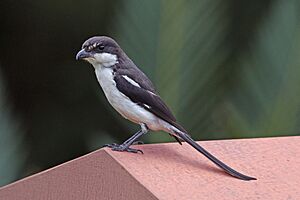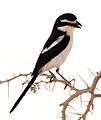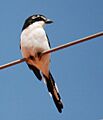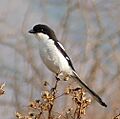Southern fiscal facts for kids
Quick facts for kids Southern fiscal |
|
|---|---|
 |
|
| L. c. subcoronatus in Walter Sisulu Botanical Garden in Roodepoort | |
| Conservation status | |
| Scientific classification | |
| Genus: |
Lanius
|
| Species: |
collaris
|
| Subspecies | |
|
See text |
|
The southern fiscal or fiscal shrike (Lanius collaris) is a cool bird found in most of southern Africa. People sometimes call it the jackie hangman or butcher bird. Why? Because it's super clever! It uses sharp thorns from acacia trees to stick its prey on. This is like a natural pantry, storing food for later. This bird used to be grouped with the northern fiscal, and together they were known as the common fiscal.
Contents
Understanding the Southern Fiscal's Family Tree
The scientific name for the southern fiscal is Lanius collaris. This name was given by a Swedish scientist named Carl Linnaeus in 1766. The word collaris comes from Latin and means "of the neck," probably because of the bird's markings.
Subspecies of the Southern Fiscal
There are five different types, or subspecies, of the southern fiscal. They are all slightly different and live in various parts of Africa.
- L. c. aridicolus – You can find this type in southwestern Angola and northwestern Namibia. It lives in the foggy dune areas of the Namib Desert.
- L. c. collaris – This is the most common type. It lives in southern Namibia, much of South Africa, Eswatini, Lesotho, and parts of Mozambique, Zambia, and Botswana.
- L. c. marwitzi (also called the Uhehe fiscal) – This subspecies lives in northeastern, central, and southeastern Tanzania, and northern Malawi.
- L. c. pyrrhostictus – This type is found in northeastern Botswana, southern Zimbabwe, and parts of South Africa and Mozambique.
- L. c. subcoronatus – You can find this one in southeastern Angola, Namibia (but not the coast), Botswana, southwestern Zimbabwe, and northern South Africa.
What Does the Southern Fiscal Look Like?
This bird is easy to spot! It's about 21–23 centimeters (8-9 inches) long. It has white feathers on its belly and black feathers on its back. The black color goes all the way from its head down to its tail.
Key Features of the Southern Fiscal
The southern fiscal has a special white "V" shape on its back. Its tail is quite long and black, with white feathers on the outer edges and white tips on the other feathers. Its beak, eyes, and legs are all black.
Male vs. Female Southern Fiscals
Adult male and female southern fiscals look very similar. The only real difference is that the female has a reddish-brown (called rufous) patch on her lower side.
Sounds and Songs of the Southern Fiscal
Southern fiscals make a mix of sounds. They have harsh alarm calls that sound like Dzzzttt-dzzzt-dzzzt. Most of their calls are for warning others or showing they are upset. Sometimes, they sing a surprisingly sweet and quiet song. This song is usually used to mark their territory or to bond with their mate.
Where Do Southern Fiscals Live?
The southern fiscal lives in many different places, or habitats. You can find them in grasslands where there are fences or tall plants for them to sit on. They also live in acacia thorn bushes and even light woodlands. However, they don't like very dense forests because it makes it hard for them to hunt.
How Southern Fiscals Handle Cold Weather
These birds can face very cold temperatures, especially in winter or in high mountains. To stay warm and save energy, their bodies change how they work. For example, they can change their body temperature and how much oxygen they use. In winter, they use more energy but let their body temperature drop a little. This helps them survive the cold.
How Southern Fiscals Behave and Hunt
The southern fiscal usually lives alone. It hunts insects and small rodents. It likes to sit on a high branch or the top of a bush, watching for its prey. The size of its hunting area, or territory, depends on how many good hunting spots there are. If there are more places for them to perch, they might have a smaller territory.
Southern Fiscals as Predators
In eastern Africa, the southern fiscal is a big hunter of the plain tiger butterfly. They are very good at catching them!
Hunting Habits Change with Seasons
Southern fiscals are smart hunters. They change how they hunt depending on the time of year and how much food they need. In summer, they hunt from an hour before sunrise until just before sunset. In winter, they only hunt during the day. To make up for less hunting time, they attack and catch prey more often. They also try to catch bigger prey in winter.
Gallery
-
L. c. subcoronatus A.Smith, 1841 — native to interior of southern Africa








